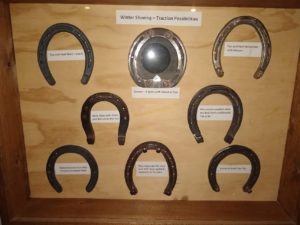Prevent Falls This Winter
This time of year it is wise to stay warm and safe when riding your horse. You want to ensure your horse has shoes that are going to give them protection from the elements of weather.
One thing that you absolutely want to make sure of is traction to prevent accidental falls in addition to winter horseshoes.
There are several options:
1) HorseshoeBorium® of screen size 8 to 10. This has the texture of coarse sand, has a mild steel matrix and is put on with an oxy-acetylene torch. It will cost several dollars per shoe. It can be put on as raised spots (best for snow and ice) or spread over the shoe (best for slick pavement).
2) Drill Tech Borium® of screen size 4 to 6. This has the texture of small gravel, has a bronze matrix and is put on in the forge on the shoe’s toe and heels. It is also expensive. It is preferred on draft horses.
3) Drive-in or screw in studs. Less expensive than Borium®. Screw-in gives the option of changing height and traction. Screw-in studs are useful in that they can be applied when the horse needs the traction (like going on a ride) and removed and the hole filled with cotton to prevent dirt fill-in when the horse no longer needs the traction (like riding in a trailer). Drive-in stud application may be easier because the holes only need to be drilled (not tapped) but once wedge shaped studs are driven into the shoe, they are difficult to remove.
4) Weld toe and heel pieces made from square stock on the shoe. These can be made sharp – called “sharp shoeing.”
5) Weld 3/8th inch nuts on the shoe across the web. These are popular on working cow horses here in Nebraska and cost considerably less to install than Borium®.
Riding horses in the winter time can be dangerous with all the ice and snow, but traction of some kind will allow the horse to do its job with confidence and safety.
Related Posts
-
Question: My mare is Twelve going on Thirteen. I have had h...Nov 16, 2009 / 0 comments
-
There are few things that can compare to the soul refreshmen...Jul 13, 2017 / 0 comments
-
©2013 Doug Butler PhD, CJF, FWCF Butler Professional Farri...Apr 10, 2013 / 0 comments
Blog Categories
- Anatomy
- Best Business Practices
- Conformation
- Current Events
- Customer Service
- Draft Horse Shoeing
- Equine Soundness
- Essential Anatomy Kit
- Farrier Careers
- Farrier training
- Foal soundness
- Horse Care
- Horse Foot Care
- Horse Owner Tips
- Horsemanship
- Horseshoeing
- Horseshoeing History
- Iron and Forge Work
- Student Spotlight
- Uncategorized
- Veterinary Care
Blog Archives
Contact Us
Butler Professional Horseshoeing School
495 Table Road
Crawford, NE 69339
(800) 728-3826
jacob@dougbutler.com
Subscribe to Our Blog
Get Our Free e-Book!
If you think you want to become a farrier (or know someone who does), this book can help you make that decision. Horse owners will learn the importance of choosing a qualified farrier and how to select the “right” one.
[ Get the e-Book Now! ]
- Follow:

